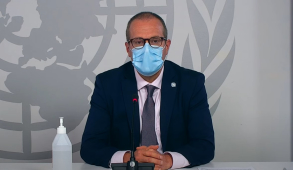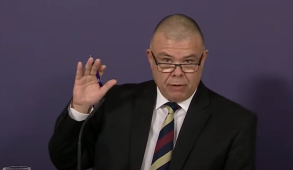Covid-19 reader: 3 September
How is the vaccination programme going across Europe?
Hans Henri Kluge, WHO European director, statement
 In roughly eight months, nearly 850 million doses of vaccine have been administered across the World Health Organization’s (WHO) European region, which includes central Asia. In total nearly half of the people in the region have been fully vaccinated – hailed by WHO regional director Hans Henri Kluge (pictured below) as a ‘remarkable achievement’.
In roughly eight months, nearly 850 million doses of vaccine have been administered across the World Health Organization’s (WHO) European region, which includes central Asia. In total nearly half of the people in the region have been fully vaccinated – hailed by WHO regional director Hans Henri Kluge (pictured below) as a ‘remarkable achievement’.
However, in a statement this week, he said that vaccination uptake had slowed down – a result of lack of access in some areas and a lack of vaccine acceptance in others. And he highlighted the startling fact that only 6% of people in lower and lower-middle-income countries had completed a full vaccination course.
While overall three out of four health workers are now fully jabbed, in some countries this is as low as one in 10. He called for an increase in production and for doses to be shared.
‘Vaccination is a right, but it is also a responsibility,’ he said. ‘The stagnation in vaccine uptake in our region is of serious concern. Now that public health and social measures are being relaxed in many countries, the public’s vaccination acceptance is crucial if we are to avoid greater transmission, more severe disease, an increase in deaths and a bigger risk that new variants of concern will emerge.’
He added that vaccine scepticism and science denial were ‘holding us back from stabilising this crisis’.
Health authorities should look closely into what determines vaccination uptake by population group and establish tailored interventions at the community level to boost vaccine uptake. The concern over vaccination levels comes against a mixed epidemiological picture across the region, which has now reported 64 million confirmed cases and 1.3 million deaths.
Thirty-three member states (out of a total of 53) were reporting a greater than 10% increase in 14-day case incidence – described by Dr Kluge as ‘deeply worrying’. And several countries are starting to observe an increased burden on hospitals and more deaths. ‘Last week, there was an 11% increase in the number of deaths in the region – with one reliable projection expecting 236,000 deaths in Europe by 1 December,’ he said.
The increases are being driven by the more transmissible Delta variant, easing of public health measures, and a seasonal surge in travel.
Third doses get green light ahead of booster programme decision
Joint Committee on Vaccinations and Immunisation, statement
Health and social care secretary Sajid Javid this week accepted the recommendations of the Joint Committee on Vaccination and Immunisation to offer a third vaccine dose – as part of their primary schedule of vaccinations – to people aged 12 and over with severely weakened immune systems.
In its advice, the committee highlighted that individuals who are immunosuppressed due to an underlying health condition or treatment may not always generate a full immune response to Covid-19 vaccination. So, this is not a booster jab, but a further primary vaccination to bring initial protection up to a sufficient level.
The committee sets out the evidence from existing studies about antibody response and vaccine effectiveness. While some have suggested benefits for immunosuppressed groups, in others the results are more difficult to interpret. However, there is an assumption that a third dose is ‘unlikely to confer significant harms or disadvantages but may offer the possibility of benefit’. Its advice is that a ‘third primary dose be offered to individuals aged 12 years and over with severe immunosuppression in proximity of their first or second Covid vaccine doses in the primary schedule.
The guidance identifies four groups of immunosuppressed individuals who are likely to be eligible for the third primary dose. These include, for example, those with leukaemia at the time of vaccination and people who had been receiving immunosuppressive therapy for an organ transplant. Deputy chief medical officer Jonathan Van-Tam (pictured) said the third dose would be ‘at a bespoke interval, advised by [the individual’s] specialist clinician, and guided by the UK’s immunisation handbook, The green book.’
He added: ‘We should be doing all we reasonably can to ensure that this group is not disadvantaged, and a third primary dose is one step in this direction. We are also working hard to ensure there are other medical interventions that can be used in these groups, including specific treatments like antivirals and monoclonal antibodies.’
However, Mr Javid underlined that this decision was not the start of the booster programme. ‘We are continuing to plan for this to begin in September to ensure the protection people have built from vaccines is maintained over time and ahead of the winter,’ he said. ‘We will prioritise those most at risk to Covid-19, including those who are eligible for a third primary vaccine, for boosters based on the final advice of the JCVI.’
The NHS had been preparing for the extension of the vaccine programme to 12- to 15-year-olds. However, it was reported on Friday that the JCVI had not backed the vaccination of healthy children aged 12 to 15 on health grounds alone, although it said the government should give consideration to wider issues such as disruption to schools.
And the committee is also deliberating on whether booster jabs should be given the go-ahead, in particular waiting to see the results from a major study expected next week. On Friday former health secretary and Commons Health and Social Care Committee chair Jeremy Hunt told BBC Radio 4’s Today programme that the government should consider moving ahead immediately.
‘If you look at what’s happened in Israel, they have a higher vaccination rate even than us – 80% of adults – and they have found a Delta variant does lead to increased hospital admissions, but two weeks after they introduced boosters, those admissions started to go down again,’ he said. ‘I understand why scientists are taking their time, but I think in a pandemic politicians can also read the runes and see the direction of travel.’
He suggested that there had been hints that the JCVI will recommend boosters. ‘In a pandemic, I think even a few days can make a big difference,’ he added. ‘So, I think we should just get on, not wait for that advice, get on with a booster programme.’
The risks of teaching during the pandemic
University of Glasgow/Public Health Scotland study, The BMJ
Teachers in Scotland were at no greater risk of hospital admission as a result of Covid-19 than adults of working age in the general population, a study published in The BMJ has found.
The study was led by the University of Glasgow in collaboration with Public Health Scotland. It covered March 2020 to July 2021 and included periods where schools were closed and fully open and also compared teachers and their household members with healthcare workers – both patient-facing and in back-office roles.
Over the study period, the risk of hospital admission with Covid-19 remained less than 1% for teachers, healthcare workers and adults of working age in the general population. The increase over time in teachers was generally similar to that in non-patient-facing healthcare workers and adults of working age and lower than in patient-facing healthcare workers.
The risk of hospital admission for teachers during each of the two periods when schools were closed was around half of that seen in the general population but increased 2.4-fold during the autumn terms of 2020 when schools were open – bringing risk in-line with that in the general population. In the summer term of 2021, when schools were also open and vaccination of the Scottish population was underway, a smaller increase of around 1.7-fold was seen.
Teachers’ lower risk than the general population during school closures is likely to be explained by them having low numbers of contacts during these periods. However, the study acknowledges that it could also be related to other factors including having more efficient immune responses from previous exposures to viruses in classrooms.
Related content
We are excited to bring you a fun packed Eastern Branch Conference in 2025 over three days.
This event is for those that will benefit from an overview of costing in the NHS or those new to costing and will cover why we cost and the processes.